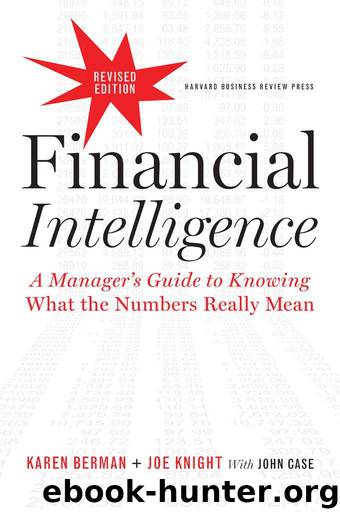Financial Intelligence, Revised Edition: A Manager's Guide to Knowing What the Numbers Really Mean by Karen Berman & Joe Knight

Author:Karen Berman & Joe Knight
Language: eng
Format: mobi
Publisher: Harvard Business Review Press
Published: 2013-01-28T16:00:00+00:00
18
How Cash Connects with Everything Else
Once you’ve learned to read the cash flow statement, you can simply take it the way it comes and inspect it for what it tells you about your company’s cash situation. Then you can figure out how you affect it—how you as a manager can help better the business’s cash position. We’ll spell out some of these opportunities in chapter 19.
But if you’re the type of person who enjoys a puzzle—who likes to understand the logic of what you’re looking at—then stick with us through this chapter. Because it may have already dawned on you: you can calculate a cash flow statement just by looking at the income statement and two balance sheets.
The calculations aren’t hard: they involve no more than adding and subtracting. But it’s easy to get lost in the process. The reason is that accountants don’t just have a special language and a special set of tools and techniques; they also have a certain way of thinking. They understand that profit as reported on the income statement is the result of certain rules, assumptions, estimates, and calculations. They understand that assets as reported on the balance sheet aren’t “really” worth what the balance sheet says, again because of the rules, assumptions, and estimates that go into valuing them. But accountants also understand that the art of finance, as we have called it, doesn’t exist in the abstract. Ultimately, all those rules, assumptions, and estimates have to provide us with useful information about the real world. And since in finance the real world is represented by cash, the balance sheet and the income statement must have some logical relationship to the cash flow statement.
You can see the connections in common transactions. For example, take a credit sale of $100. It shows up as:
• an increase of $100 in accounts receivable on the balance sheet, and
• an increase in sales of $100 on the income statement
When the customer pays the bill, here’s what happens:
• accounts receivable decreases by $100, and
• cash increases by $100
These changes both appear on the balance sheet. But because cash is now involved, the transaction affects the cash flow statement as well.
You can watch the effect of all sorts of transactions in just this manner. Say a company buys $100 worth of inventory. The balance sheet records two changes: accounts payable rises by $100 and inventory rises by $100. When the company pays the bill, accounts payable decreases by $100 and cash decreases by $100—again, both on the balance sheet. When that inventory is sold (either intact, as by a retailer, or incorporated into a product by a manufacturer), $100 worth of cost of goods sold will be recorded on the income statement. The cash parts of these transactions—the original disbursement of cash to cover the $100 in accounts payable and the later receipt of cash from the sale of finished goods—will show up on the cash flow statement.
So all these transactions ultimately have an effect on the income statement, the balance sheet, and the cash flow statement.
Download
This site does not store any files on its server. We only index and link to content provided by other sites. Please contact the content providers to delete copyright contents if any and email us, we'll remove relevant links or contents immediately.
Hit Refresh by Satya Nadella(8854)
The Compound Effect by Darren Hardy(8511)
Change Your Questions, Change Your Life by Marilee Adams(7374)
Nudge - Improving Decisions about Health, Wealth, and Happiness by Thaler Sunstein(7242)
The Black Swan by Nassim Nicholas Taleb(6765)
Deep Work by Cal Newport(6563)
Daring Greatly by Brene Brown(6225)
Rich Dad Poor Dad by Robert T. Kiyosaki(6176)
Principles: Life and Work by Ray Dalio(5961)
Man-made Catastrophes and Risk Information Concealment by Dmitry Chernov & Didier Sornette(5649)
Playing to Win_ How Strategy Really Works by A.G. Lafley & Roger L. Martin(5501)
Digital Minimalism by Cal Newport;(5389)
Big Magic: Creative Living Beyond Fear by Elizabeth Gilbert(5352)
The Myth of the Strong Leader by Archie Brown(5238)
The Slight Edge by Jeff Olson(5200)
Discipline Equals Freedom by Jocko Willink(5157)
The Motivation Myth by Jeff Haden(5003)
Stone's Rules by Roger Stone(4857)
The Laws of Human Nature by Robert Greene(4773)
